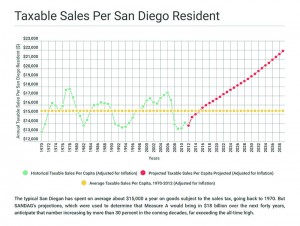 The regional planning agency in charge of transportation around the county admitted it won’t have enough money for projects it already promised to voters.
The regional planning agency in charge of transportation around the county admitted it won’t have enough money for projects it already promised to voters.
SANDAG, the San Diego Association of Governments, comprised of elected officials from each of the 18 cities and the county, manages freeway and road improvements, public transportation projects, and bicycle paths funded by local, state, and federal money.
Last week, SANDAG staff admitted that it had overstated the revenues it expected to raise from the TransNET ½ cent sales tax increase voters passed in 2004 to fund a list of regional highway improvements. The projects, used to entice voters to tax themselves, have also increased in cost, so the combined funding gap could be more than $17.5 billion.
Before admitting the shortfall, SANDAG tried to backfill that funding gap this year when it put Measure A on the ballot to raise sales taxes by another ½ cents for 40 years. SANDAG ran a public information campaign to gain support for Measure A, and construction labor unions poised to benefit from the projects spent over $1,000,000 on a political campaign. In the end, though, not enough voters supported the ballot measure to secure the required two-third vote threshold to pass it.
SANDAG has long been the go-to local agency for population growth forecasts and economic modeling. The cost and revenue projections used both in 2004 and 2016 to rally support for the sales tax increases were generated internally by SANDAG. In fact, most cities in the county point to SANDAG for their own traffic and growth forecasts.
Now, SANDAG’s numbers are in question. Their staff now admits they used overly optimistic forecasts of future taxable sales to calculate tax revenues for projects.
In fact, the projections not only expected us to spend more money in the future, but to spend more money than San Diegans have ever spent before, even after adjusting for inflation. Their projections also assumed that spending would increase year after year for 30 years, without any reductions during economic recessions or crashes. Since 1970, we have experienced five ups and downs, yet the projections in SANDAG’s chart (inserted below)shows no such economic downturns.
SANDAG’s projections have been criticized by Robert Puentes, President of the Eno Center on Transportation, a Washington, D.C.-based think tank that reviews local transportation tax spending. Puentes called SANDAG’s rosey projections as “extraordinary”, but not in a good way.
Another group, the Rockefeller Institute of Government, says it’s unreasonable to expect spending growth beyond our historical average because most trends are showing declining tax revenues.
But the more shocking aspect of SANDAG’s admission last week was that not a single elected official on their Board spoke up when the huge underfunding was announced.
Representatives from each city and County Board of Supervisors are members of the Board, but not one raised concerns about how projects will be completed, or how we will pay for the funding shortfall. And not one was critical of SANDAG’s staff for their estimates, and not one took responsibility for blindly supporting their staff.
SANDAG board members, each already an elected councilmember or mayor of a city, or a member of the County Board of Supervisors receiving a public salary, take an additional monthly public stipend for attending SANDAG meetings. Members are paid up to $150 per meeting, and some members earn up to $4,800 per year for their participation on SANDAG’s boards and committees.
And what do taxpayers get from this unelected board of elected officials?
Voters shot down Measure A’s proposed sales tax increase in last month’s election. Had voters known the representations made in the campaign were inaccurate, surely even fewer would have supported it.
But what if Prop A had passed? Would taxpayers have ever known that traffic congestion reduction projects they were promised were in jeopardy of being unfunded, or would the new money have covered up the erroneous projections?
SANDAG must conduct a truly transparent review of its internal modeling and explain to taxpayers what projects can now be completed, and where we will fall short.
Only then can San Diegans make informed decisions on any future tax increases to fund new projects, and start to rebuild confidence in our regional planning leaders.
Don’t worry SANDAG, we can handle the truth.
Category